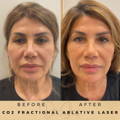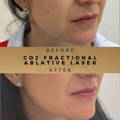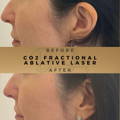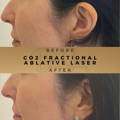CO2 Fractional Ablative Laser
Targets
Pitting of the skin
Pigmentation
Enlarged Pores
Open Pores
Premature Ageing
Skin Irregularities
Sun Damage
Lines and Wrinkles
Dull Complexion
Stretch Marks
Loose Skin
Scars
For all skin types, At Dr Sknn we offer an advanced fractional CO2 laser for face, neck, décolleté and body areas by allowing new skin production which is stimulated within the dermis and epidermis through ablation and thermal effect which is delivered over the skin in a methodical even pattern with precise spacing between each laser emission, the tissue in-between is spare resulting in a faster healing process.
We use this specific mid-infrared CO2 laser at 10,600 nm to treat a variety of aesthetic concerns including fine lines, wrinkles, dyschromia, pigmented lesions, skin surface irregularities, enlarged pores, texture, unwanted scars, sun damage, stretch marks and loose skin to improve pitting of the skin, pigmentation, pore minimisation, premature ageing, skin hyperplasia, sun damaged skin, lines, wrinkles and skin complexion ultimately improves the thickness and hydration of the dermis and epidermis resulting in a healthier, glowing, youthful appearance of the skin.
By utilising the power of CO2, the laser energy is applied to the skin in a fractional way, by creating longitudinal microthermal zones in the skin penetrating to approximately 2mm in depth through to the dermis. This thermal damage creates trauma to the existing cells in the skin thus promoting collagen formation. The space between the columns of intact epidermis allows the skin to trigger a faster healing response of the damage tissue achieving better results with less down time.




CO2 Fractional Ablative Laser
Targets
Pitting of the skin
Pigmentation
Enlarged Pores
Open Pores
Dull Complexion
Stretch Marks
Premature Ageing
Skin Irregularities
Sun Damage
Lines and Wrinkles
Loose Skin
Scars
For all skin types, At Dr Sknn we offer an advanced fractional CO2 laser for face, neck, décolleté and body areas by allowing new skin production which is stimulated within the dermis and epidermis through ablation and thermal effect which is delivered over the skin in a methodical even pattern with precise spacing between each laser emission, the tissue in-between is spare resulting in a faster healing process.
We use this specific mid-infrared CO2 laser at 10,600 nm to treat a variety of aesthetic concerns including fine lines, wrinkles, dyschromia, pigmented lesions, skin surface irregularities, enlarged pores, texture, unwanted scars, sun damage, stretch marks and loose skin to improve pitting of the skin, pigmentation, pore minimisation, premature ageing, skin hyperplasia, sun damaged skin, lines, wrinkles and skin complexion ultimately improves the thickness and hydration of the dermis and epidermis resulting in a healthier, glowing, youthful appearance of the skin.
By utilising the power of CO2, the laser energy is applied to the skin in a fractional way, by creating longitudinal microthermal zones in the skin penetrating to approximately 2mm in depth through to the dermis. This thermal damage creates trauma to the existing cells in the skin thus promoting collagen formation. The space between the columns of intact epidermis allows the skin to trigger a faster healing response of the damage tissue achieving better results with less down time.




How Does the CO2 Laser Work?
What should I expect during the Consultation?

Can I have the Treatment Immediately?

What should I expect during the Consultation?
At Dr Sknn, during the consultation a medical history including a physical examination will be performed including photographs. During the consultation there will be an opportunity to discuss any concerns, expectations, results, or questions you may have. Prior to the treatment any post treatment advice and risks associated with the treatment are discussed ensuring you fully understand them and a consent form is signed. Furthermore, if it is a new area being treated a small patch test will be performed in order to ensure suitability. If you are found to have a skin type of III+ then prior to treatment a topical application of serum may be needed for 4 weeks prior to treatment.

Can I have the treatment Immediately?

Before & Afters
Acne Scarring
Skin Rejuvenation
Wrinkle Reduction
Pigmentation
Open Pores
Stretch Marks
Frequently Asked Questions
How do I prepare for the treatment?
Some of the pre-treatment advice is listed below. Please note that during the consultation you will be provided with a complete list.
If you have a skin type of III+ then prior to treatment atopical application of product may be needed for 4 weeks prior to treatment.
Do not use products containing retinol or strong AHA fruitacids on the treatment area prior to or during your skin resurfacing treatment,please stop using the products 5 days before, they can be restarted 5 days postthe treatment
What is the after care advice?
Some of the post-treatment advice is listed below. Please note that during the consultation you will be provided with a complete list.
If you have a skin type of III+ then prior to treatment a topical application of product may be needed for 4 weeks prior to treatment.
Do not use products containing retinol or strong AHA fruit acids on the treatment area prior to or during your skin resurfacing treatment, please stop using the products 5 days before, they can be restarted 5 days post the treatment
No hot baths or showers – tepid only. Skin should be keptdry for 3 days or until the skin normalises. If you can keep the skin dry for24 hours after treatment it will increase the treatment efficacy.
Cooled boiled water can be used to wash the skin for thefirst 3 days post treatment if necessary.
How many treatments are required?
The required number of treatments varies on multiplefactors, typically a course of treatments are required to achieve optimalresults.
For Skin Rejuvenation, Wrinkles and Lines: A course of 3-5treatments is recommended, with each treatment delivered every 3-4 weeks.
For Photodamaged Skin, Skin Hyperplasia and scarreduction: A course of 4-6 treatments isrecommended, each treatment delivered every 4-5 weeks.
Every how long can I have the treatment:
Treatment intervals should be no less than 3 weeks, howeverdepending on the indication the recommendation for Skin Rejuvenation, Wrinklesand Lines is every 3-4 weeks and for Photodamaged Skin, Skin Hyperplasia and Scar Reduction is every 4-5 weeks.
What to expect during the treatment
What can I expect immediately after the treatment?
During treatment the skin will be stimulated and will becomeslightly pink/red, it is a similar feeling to when you have been in the sun.The pinkness/redness can last for up to 48 hours depending on your skinsensitivity.
Flaking may occur over the following days, do not pick orscratch the skin as this may result in infection or scarring
Who is unsuitable for the treatment?
Some of the contraindications are listed below. Please note that during the consultation we will assess suitability for the treatment
Age below 18
Pregnancy, recent pregnancy or breast feeding
Suntanned Skins
Am I suitable for the treatment?
Yes as long as you are over the age of 18 and have nocontra-indications. However the treatment will only be performed following aconsultation.
How long does the treatment take?
Treatments last anywhere between 15 to 45 minutes dependingon which treatment you have.
What will I feel during the treatment?
There is a slight tingling sensation and warmth during thetreatment however an anaesthetic cream is applied prior to treatment to reducethe sensation on the skin.
Are there any side effects?
During treatment the skin will be stimulated and will becomeslightly pink/red, it is a similar feeling to when you have been in the sun.The pinkness/redness can last for up to 48 hours depending on your skinsensitivity.
Additionally swelling and white spots/bumps will be present.
Flaking may occur over the following days, do not pick orscratch the skin as this may result in infection or scarring
Furthermore small squares can last up to 2 weeks and this isnormal.
Is there any downtime following treatment?
There is a slight downtime with this treatment which lastsbetween 3 to 5 days, however, your skin surface can become dry and slightlyflaky as the new skin cells are stimulated in the deeper layers of the skin.Furthermore small squares can last up to 2 weeks and this is normal. Rednessand swelling may also be present.




















